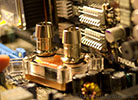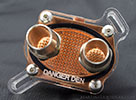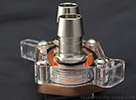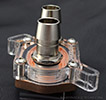

Danger Den MPC-Universal Chipset Block Review
Introduction

Welcome to my review of the latest in chipset water cooling. With motherboard chipsets becoming ever increasingly stressed, you'll noticed an increased emphasis by manufacturers to incorporate stronger and more robust heat-pipe type coolers to keep these components in check thermally. These coolers generally rely on secondary active cooling provided by the CPU fan on a stock or other driven fan cooler. Unfortunately the negative result of water cooling the processor often times leaves an over-clocker with less than adequate air flow over these components making them more passive cooling solutions and possible bottlenecks. One option to counteract this is using a small and high rpm (loud) fan that's part of the motherboard package, a second is the option of using aftermarket air coolers, and the third option is water cooling those chipsets. Most of the past water blocks for chipset cooling have nothing more than a flat slab of copper. This is where this block stands out, Danger Den has provided us with a chipset block that utilizes more of a CPU micro-pin design to maximize surface area and heat transfer. Let's find out how this block performs both hydraulically and thermally.
The MPC-Universal is aimed at providing chipset cooling for a wide range of motherboards. As noted in the specifications the hole spacing compatibility is from 2.10" to 2.43" (53.3mm to 61.7mm), but it is up to the user to ensure there is compatibility with their application. It's not uncommon for a user to have to make a slight modification to fit their motherboard. In my case with an EVGA 680i, there is not a chipset block made for the southbridge that doesn't require some modification, unfortunately the problematic 680i continues to be a not so compatible board with this block as well, but it can be with a little work depending on your setup. On to this new chipset block review!
Package Contents
 Let's
enjoy our typical "opening up a new present" moment and see what you
get as part of the packaging. First off my box of Danger Den
goodies arrived via FedEx in a well packaged box, and the delivery
person even range my doorbell to hand deliver the package, that was a
nice pleasant surprise! I received several products that were
all
boxed nicely in a standard box with packaging peanuts and it was
professionally packaged box in a box style double protection.
Let's
enjoy our typical "opening up a new present" moment and see what you
get as part of the packaging. First off my box of Danger Den
goodies arrived via FedEx in a well packaged box, and the delivery
person even range my doorbell to hand deliver the package, that was a
nice pleasant surprise! I received several products that were
all
boxed nicely in a standard box with packaging peanuts and it was
professionally packaged box in a box style double protection.Specifications
- Designed to fit a broad range of motherboards
- Fits most motherboards with hole spacings of 2.10" to 2.43" (53.3mm to 61.7mm)
- 100% Copper C110
- High Flow 1/2" or 3/8" OD Fittings
- Stainless Steel Hold Down Pan-head Bolts
- Machined Lapped and polished beyond 1200 grit
- Pressure tested before shipment to 85 psi
Photo Gallery
Here are several pictures I've taken at different angles and distances to give you a good viewing of the block for yourself. I'm mixing a few others within the entire review as well, but here is a large majority of the pictures for your viewing pleasure. (Click thumbnails to enlarge):Heat Transfer Surface Area
One element of design that stands out for this chipset block is it's massive amount of heat transfer surface area due to the micro pin design. Heat transfer between your coolant and the water block occurs at the surface of the blocks base. For a simplistic comparison, I'll compare surface area that comes in contact with the coolant. Below are measurements taken of this block's copper base to determine that contact area.Construction, Materials, Quality, and Aesthetics
Overall construction of the block and attention to detail is superb.The base is very finely cast from C110 copper and having seen some casting problems in past on other blocks, I was pleasantly suprise that I could not find
 any.
These pins are very nearly reaching the limits of how small
copper pins can be cast, and they are done so perfectly in my sample.
The base bottom is very adequate in finish, you can see by the
photo above in the gallery how it is a nicely finished base nearly a
mirror in reflection and a straightedge test proved flatness to be
excellent. It's
fairly common knowledge that lapping a base much beyond 1000 grit no
longer yields additional performance gains, so the specified 1200 grit
is more
than adequate.
any.
These pins are very nearly reaching the limits of how small
copper pins can be cast, and they are done so perfectly in my sample.
The base bottom is very adequate in finish, you can see by the
photo above in the gallery how it is a nicely finished base nearly a
mirror in reflection and a straightedge test proved flatness to be
excellent. It's
fairly common knowledge that lapping a base much beyond 1000 grit no
longer yields additional performance gains, so the specified 1200 grit
is more
than adequate. The top is fabricated of 3/8" (9.3mm) thickness acrylic sheet and is very precisely CNC machined and the edges are nicely finished. Some folks may not prefer the use of Acrylic (Lucite) due to durability concerns. I don't believe it to be an issue on this block because of the proper design techniques used. Regardless for you all metal block-heads out there, Danger Den has produced the same top in a brass option for you to choose from!
The barbs are nickel plated brass, (no flimsy cheap plastic barbs here!). Using my digital calipers the inside diameter is a heavy 10.15mm, that's as bored out as it gets for G1/4 threading. The barbs have all been installed and the block pressure tested at 85psi, so no worries about leaks, you shouldn't have to touch these barbs, they come preinstalled and pressure tested. On some of my other blocks that came with plastic barbs, I had a hard time getting tubing back off of them and getting tubing onto them without the barbs turning on me, brass barbs don't have that problem.
The block screws as previously noted are a stainless round-head type screw that appears to be a nice 6-32 screw dimension and the head itself receive a standard 2mm allen head. All of the remaining mounting hardware appears to be in good order, nice larger brass thumbscrews and the necessary studs, springs, nuts and washers and appear to be in the 4-40 threading form.
The block is very nice to look at with a high level attention to detal. Perhaps it's due to the transparent top, or perhaps it's the design of the copper mini pin matrix base and all that surface area for heat conductivity. I also appreciate the integrated hold down and top. A personal preference of mine is to have a top that looks custom. The block exceed my expectations in this area, but I encourage you to look more at the pictures and decide for yourself.
Hydraulics and Pressure Drop Testing
 The
most scientific way to determine a blocks hydraulic resistance is to
test pressure drop. Pressure drop is as it sounds, it's the
measurement of pressure difference or friction across a block. In
water cooling we have a specific amount of energy that our pump can
produce, and it produces that energy in two primary forms. One is
flow rate (which is constant throughout a water cooling loop), and the
second in pressure energy which lowers as it encounters resistance
until it reaches the pump again. This pressure energy is used up
by resistance. So pressure drop is really just a measurement of
energy loss and this varies depending on the flow rate. To
measure pressure drop, you need the ability to measure the pressure
difference (Manometer), a flow rate meter, and a source of variable
water pressure and flow. I typically log pressure delta and flow
rate at .5GPM increments until I either max out my flow rate meter or
digital manometer, this gives me a larger data set to create a more
accurate trend-line in excel and spot any errors.
The
most scientific way to determine a blocks hydraulic resistance is to
test pressure drop. Pressure drop is as it sounds, it's the
measurement of pressure difference or friction across a block. In
water cooling we have a specific amount of energy that our pump can
produce, and it produces that energy in two primary forms. One is
flow rate (which is constant throughout a water cooling loop), and the
second in pressure energy which lowers as it encounters resistance
until it reaches the pump again. This pressure energy is used up
by resistance. So pressure drop is really just a measurement of
energy loss and this varies depending on the flow rate. To
measure pressure drop, you need the ability to measure the pressure
difference (Manometer), a flow rate meter, and a source of variable
water pressure and flow. I typically log pressure delta and flow
rate at .5GPM increments until I either max out my flow rate meter or
digital manometer, this gives me a larger data set to create a more
accurate trend-line in excel and spot any errors.Equipment:
- Dwyer Digital Manometer 475 Mark III - Accuracy .5% of Full Scale. Range 0-200" W.C., Resolution .1" W.C.
- King Instruments 7520 Series 0-5GPM, 250mm scale - Accuracy 2% of Full Scale. Range 0-5GPM, Resolution .1GPM (can be interpolated to .02GPM)
- Water Source - Household water pressure - 50PSI at >5GPM - Because flow rate readings are instantaneous, household tap water and water pressure are a good and powerful source for pressure drop testing.
The pressure drop testing results were about typical of a round pin matrix style CPU block with one way flow, slightly less than most square or diamond pin type blocks.

So, as expected, the increased surface area does create more restriction than a flat base, but as with any block design you tend to make trade offs between restriction and thermal performance. You need the surface area and increased velocities for good heat transfer, but you can't do that without some added restriction. The added heat transfer area will perform better thermally than a flat base, so the question is: What does this increased pressure drop mean for other blocks in the same loop? I'll try to answer than in this next section.
Flow Rate Differences
For one example lets select an assumed system and compare flow rates:
D-Tek Fuzion with 5.5mm nozzle, PA120.3, 7' of 7/16" ID tubing, one reservoir, Laing D5 setting 5:
- Swiftech MCW 30 = 1.34 GPM
- DD MPC-Universal = 1.19 GPM
Flow Rate Delta = .15 GPM
Thermal Performance Differences of Other Blocks
Now let's look at how this small flow rate change will affect temperature of the CPU block. Just for an example, per D-Tek's site a stock fuzion even without a nozzle has a thermal performance curve something like this:
C/W at 1.0 GPM = .033
C/W at 1.3 GPM = .032
So for a .15 GPM difference the C/W difference should be approximately .0005.
An E6600 C2D consumes approximately 109 watts when over-clocked to 3.3Ghz and 1.38 Vcore.
Fuzion in same loop temperautre difference = .0005c/w X 109w = 0.05 degrees.
Less than one tenth of one degree. I'm ignoring the radiator C/W for this rough estimation and reduced heat dump from the pump, but for general comparison I think it's fair to say, there is a negligible difference in temperature affects on other blocks. For most systems, you'll see several degrees better chipset cooling and flow rates will still be well within strong performing ranges.
Installation on an Evga 680i
The installation on the 680i south-bridge required moderate modification to be compatible with my longer than typical 8800 GTX and 680i. It turns out the 680i is poorly designed to accomodate universal chipset cooling and was in conflict with both this block and the spare MCW-30 I had on hand. The conflict lies with the block top mount height conflicting with the bottom of an 8800 GTX card and the top mounting bolt. It should also be noted that the barbs could also conflict with a double slot VGA card solution or full coverage GPU block. The MPC-Universal requires both bolt shortening, and one more step of either countersinking a screw (easiest) or removing material off the mount to lower the mount hieght. Since I wanted to have the ability to remove the block from the motherboard while mounted to the case, I chose to remove material from the top of the block.MCW-30 Conflict |
MPC-Universal Conflict |
MPC-Universal Solution |
After completing the block modification, installation was very straight forward. Considering the block comes fully assembled, you just need to assemble the mounting hardware and the rest is done.

To the right you will see a full 680i board photo with the block modified and mounted in place. It is likely not compatible on the 680i with a two slot solution (8800 series card with stock air cooling) and it's unknown if it would conflict with full coverage water-blocks. I can confirm compatibility with a GPU only block on an 8800GTX
Thermal Testing
At this current time I only have a comparison of thermal performance using the motherboards health monitor and the stock heat-pipe cooler with fan attached. Results are as follows:21C ambient equivalent
Water Cooling loop is two Danger Den MPC chipset coolers, an MCR220, D5 variable, Yate Loon fans
- Ambient to MCP delta = 10C
- Ambient to coolant delta = 2.5C
- Coolant to MCP delta = 7.5C
 So for a 21C ambient temperature
So for a 21C ambient temperature
- Stock Heat-pipe sink with fan attached = 51C
- Thermal HR-05 Plus with 80mm fan = 36C
- MPC-Universal = 31C

Conclusion and Recommendation
To provide some sort of recommending criteria, I'm establishing the following with a 0-10 scale of excellence.| Criteria | Rating | Notes |
| Design | 10 | I'd give it more if I could, glad to see the unique and well performing design |
| Quality | 10 | I'm very impressed by the flawlessness of all parts included |
| Compatibility | 9 | This is specified as a "Universal" block, so it was not specifically designed for the 680i |
| Materials | 10 | Multiple top options make this a 10. |
| Pressure Drop | 9 | More restrictive than other chipset blocks, but still good |
| Thermal Performance | 10+ | A significant step above all the rest, 10+! |
| Overall | 9.7 | Superb!! |
The MCP-Universal is a fantastic block design that is unparalleled in thermal performance. The micro pin matrix design common to CPU blocks provides over FOUR TIMES the amount of heat transfer surface area that a similar flat based chipset block will provide. It provides an extreme solution to chipset cooling and it has permanently found a happy home in my water cooling system replacing my previous air cooled solution. Highly recommended!
Where to buy
Danger Den's Website







